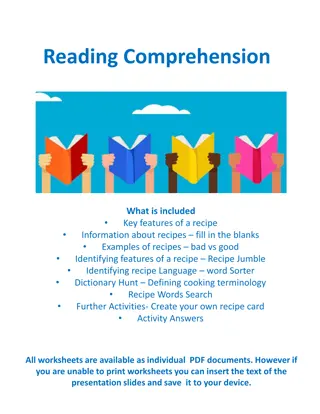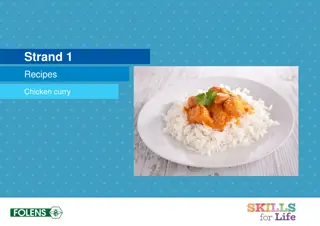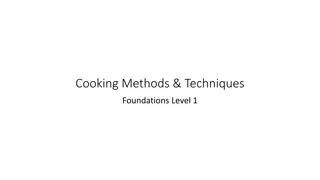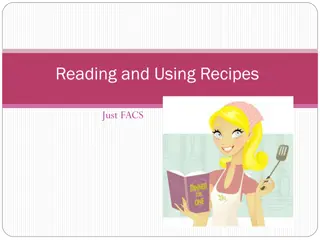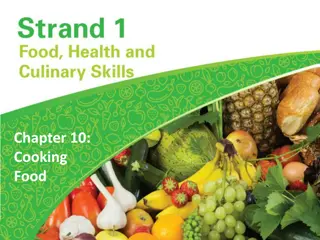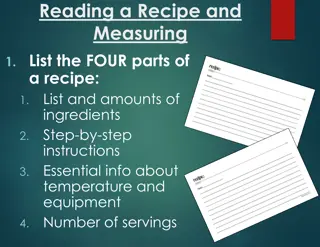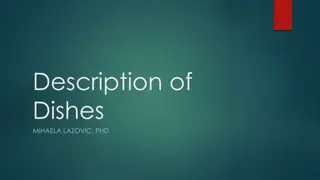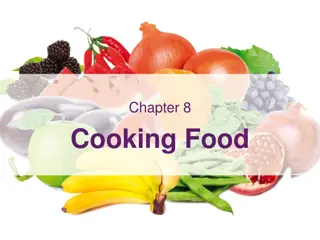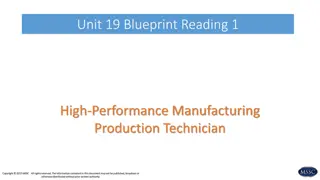Mastering Recipe Basics: Understanding the Blueprint of Cooking
Unlock the essence of recipes as blueprints for culinary creations in this detailed chapter. Learn to identify ingredients, equipment, cooking techniques, and more, ensuring a seamless cooking experience every time.
Download Presentation

Please find below an Image/Link to download the presentation.
The content on the website is provided AS IS for your information and personal use only. It may not be sold, licensed, or shared on other websites without obtaining consent from the author.If you encounter any issues during the download, it is possible that the publisher has removed the file from their server.
You are allowed to download the files provided on this website for personal or commercial use, subject to the condition that they are used lawfully. All files are the property of their respective owners.
The content on the website is provided AS IS for your information and personal use only. It may not be sold, licensed, or shared on other websites without obtaining consent from the author.
E N D
Presentation Transcript
CHAPTER 10 RECIPES BLUEPRINTS FOR FOOD WEEK 5
OBJECTIVES AFTER READING THIS CHAPTER, YOU WILL BE ABLE TO: 1. describe the parts of a recipe 2. define recipe terms 3. measure ingredients accurately.
NEW TERMS Recipe: A list of ingredients and directions for preparing a food. Yield: The number and size of portions a recipe will make.
A recipe is a blueprint for preparing food. A recipe is a plan that tells a cook how to build a food. A builder looks at the blueprint to see what building supplies are needed. A cook looks at a recipe to see what ingredients are needed. If a builder follows the blueprints exactly they will get the same house every time If you follow a recipe exactly, you will get the same food every time.
WHERE CAN YOU FIND RECIPES? Cookbooks The internet Newspapers Magazines Through friends Through family.
A recipe tells you exactly what you must do to make the food. It tell you: (can be divided into 5 parts) 1. What ingredients you need 2. Cooking equipment 3. Cooking time and temperature 4. Steps to follow 5. yield
INGREDIENT LIST This list tells you which ingredients are needed to make the recipe. Tells you the amounts of each ingredient. Recipes that are the easiest to use list the ingredients in the order they are used. List the exact form of each ingredient. (low-fat cheese) This list helps you have your shopping list. Sometimes you can substitute one ingredient for another. Some cookbooks have a substitution list. Use the list to get out all the needed ingredients. Arrange them in the order they are needed. You will be able to make the recipe without stopping and searching for an ingredient.
COOKING EQUIPMENT NEEDED Most recipes tell you how to prepare the food, but do not say the equipment needed. Most cases, if you look at what the recipe tells you to do, you can use common sense to figure out equipment needed. Example slice a carrot. Sometimes specific equipment is listed. Example large mixing bowl. A recipe may tell you to use a pan of a certain size. It is important to use the right size pan. If too small, ingredients may overflow, if too large ingredients will spread out, they may cook too quickly.
COOKING TEMPERATURE AND TIME. Some recipes give you can exact cooking temperature and time. Example: Cook the food at 350 degrees F Other recipes tell you how to cook the food. Example: Heat water until it boils. Simmer sauce until thick
STEPS TO FOLLOW These describe what you MUST do to prepare a recipe. They are list in order they should be done. Sometimes the steps are numbered. Other times they steps are written in paragraph form. Some steps tell you how to get ingredients and equipment ready. Other steps state how and when to combine ingredients. Steps also explain what to do with the blended ingredients.
YIELD Is the number and size of portions a recipe will make. Tells you how many people you can serve. Tells you how much each person will get. Helps you decide if you need more or less food than the recipe will make. So you can choose to cut a recipe in half, or make the whole recipe and have leftovers.
Recipes have a language all their own. It is made up of terms that describe exactly how to prepare, combine, or cook ingredients. Language is easy to learn The meaning of some terms are alike, meaning do differ. You need to know how they differ. You are more likely to have a successful recipe if you know the recipe language
GETTING READY TO COOK! Some equipment needs to be prepared before you use it. These terms tell you how to get cooking equipment ready.
Grease: To rub or spray lightly with fat or oil. Preheat: To heat a conventional oven to the cooking temperature before putting food in the oven. These terms tell you how to handle ingredients: Sift: To put dry ingredients through a flour sifter. Baste: To moisten foods during baking or roasting with fat, juice, or sauce. Add flavor and keeps food moist Drain: To remove liquid from a food by pouring off the liquid or drying the food with paper towels.
GETTING UNDER THE SKIN Some fruits and vegetables need to have their skin removed. Recipes tell you when to do this. Terms: Scrape: To remove a very thin layer of outer skin by rubbing it with a knife or vegetable peeler. Pare: To cut off out skin with a knife or vegetable peeler Peel: To strip or pull off the outer skin using your fingers or a knife.
ANYWAY YOU SLICE IT There are many ways to cut foods. Some are cut in large pieces Others are cut very small. The terms used in a recipe tell you how to cut the ingredients.
TERMS LISTED FROM THE LARGEST PIECES TO THE SMALLEST Slice: To cut into flat pieces. May be thick or thin. Julienne: To cut into long, very thing strips the size of matchsticks. Shred: To cut into long, very thin strips using a knife or the large holes of a grater. Cube or dice: To cut into cubes about inch thick in size
Grate: To cut into small pieces using the small holes of a grater Chop: To cut into small uneven pieces Mince: To cut into very small pieces. Puree: To grind or mash food until it becomes a smooth and liquid Grind: To crush into very thin bits by putting food through a food grinder.
slice Julienne
C u b e Shred
Grate Chop
Mince Puree
MIXING INGREDIENTS There are many ways to combine ingredients. Some are slow using gentle motions Others are fast using forceful motions Stir, mix, blend, beat, cream and whip have similar meanings They mean to combine ingredients with a spoon, wire whisk, beater, or electric mixer. Main difference is the speed and force of motion used.
MIXING TERMS ARRANGED IN ORDER FROM GENTLEST MOTION TO MOST FORCEFUL. Fold: gently combine ingredients, to do: slice a spatula down through the center of a mixture, then slide the spatula across the bottom and up the side, gently lifting and turning the ingredients. Repeat steps until well blended. Knead: to press and fold a ball of dough with the heels of your hands until the dough is smooth and elastic.
Fold Knead
Stir: to slowly move a spoon in a circle to combine ingredients Mix: to combine ingredients by stirring or beating them Blend: to mix ingredients until they are very smooth Beat: to stir quickly with a spoon, wire whisk, beater, or mixer until ingredients are smooth
Stir Mix
Blend Beat
Cream Whip
Cut in To combine solid fat, such as shortening, with a flour mixture by cutting the fat into tiny pieces with knives or a pastry blender.
COOKING WITH FAT Foods cooked in hot fat are called fried foods. Cooked in an uncovered pan. Fat is added to the pan in all types of frying except pan-broiling. The amount of fat added to the pan varies. Deep frying uses the most fat. Stir frying requires the least fat. The fat used in pan broiling comes from the meat being cooked.
Saute: to brown or cook lightly and quickly in a small amount of hot fat. Also called pan frying. Deep fry: to cook food by completely immersing it in hot fat, also called French frying. Stir fry: to cook pieces of food quickly in a very small amount of hot fat. Food is stirred throughout cooking. Pan-broiling: to cook meat in its own fat, the fat melts as the meat cooks. The fat is poured off as it collects.
COOKING WITH LIQUIDS Food can be cooked in any hot liquid Often water or milk Other liquids too, yogurt is an example. Some are cooked in a large amount of liquid Others are cooked in a small amount Boiling and poaching use large amounts of liquid Small amounts are used to steam or braise foods.
Most foods cooked in liquid are prepared on the cooktop Some are cooked in the oven May be covered or uncovered. Your recipe will tell you the type and amount of liquid to use and how to heat it. It will also tell you if the pan needs to be covered.
Blanch: to put a food in boiling water for a very short time to precook it. Boil: to cook in hot liquid that has bubbles that rise and break on the surface of the liquid. Braise: to cook large pieces of meat or poultry slowly in a small amount of hot liquid Parboil: to boil until partly cooked. Cooking is finished using another method.
Poach: to cook gently in enough hot liquid so that the food can float. Scald: to heat milk just until tiny bubbles form at the edge of the pan Simmer: to cook in liquid that is almost boiling, but is not hot enough to bubble. Stew: to slowly cook small pieces of food in moderate amounts of liquid. Steam:To cook in a pan using steam that rises from boiling liquid.
COOKING WITH DRY HEAT No fat or liquid is added Mainly cooked in an oven or toaster or on a grill.
Bake: to cook in hot air in an oven Barbecue: to roast slowly over hot coals or in an oven and baste with a spicy sauce Broil: to cook directly under a very hot heating unit in an oven Brown: to make the surface of a food brown by baking, broiling, or toasting it. Roast: to bake meat, fish, or poultry uncovered in hot air in an oven or over hot coals. Toast: to brown foods using dry heat, usually in an oven or toaster.
COOLING FOODS Some foods are served cold. Recipes may instruct you to cool, chill or freeze ingredients. Cool: to let heated food come to room temperature Chill: to put food in the refrigerator to make it cold. Freeze: to lower the food s temperature to its freezing point or below.
Success with recipes depends on accurate measurements. If measurements are off, even the best recipe won t look and taste good. Many recipes use abbreviations (a shortened form of a word)
COMMON ABBREVIATIONS c C F g or gm Kg L lb or # ml oz pt qt t or tsp T or tbsp Cup Degrees Celsius Degrees Fahrenheit Gram Kilogram Liter Pound Mililiter Ounce Pint Quart Teaspoon tablespoon
INGREDIENT AMOUNTS May be given as units, weights, or volumes. Units tell you how many of an ingredient you should use. Such as 2 eggs Weights tell you how heavy an ingredients should be Such as 20 pounds of flour. Volume: is the space an ingredient occupies. Such as a cup of flour. You use measuring cups or spoons
COMMON MEASURING CUPS OR SPOONS Measuring Cups Measuring Spoons 1 cup 1 tablespoon cup 1 teaspoon 1/3 cup teaspoon cup teaspoon
Volume ingredients can either be dry or liquid. Dry ingredient examples Sugar Flour Shortening Liquid ingredients examples Milk Water oil
The method used to measure dry ingredients differs from the method used to measure liquid ingredients. Knowing how to measure each type of ingredients helps you to get the exact amount needed. Success depends on accurate measurements
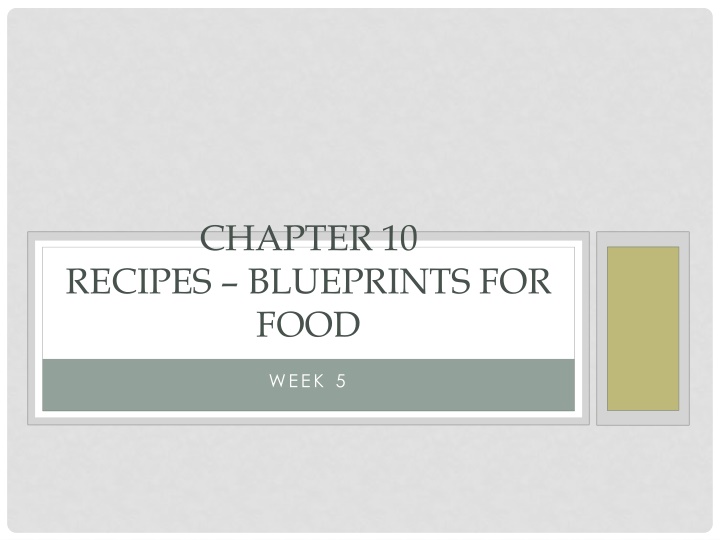

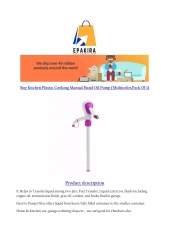


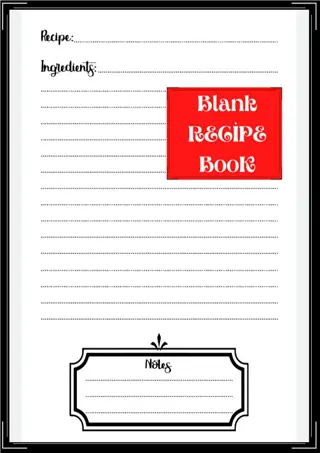
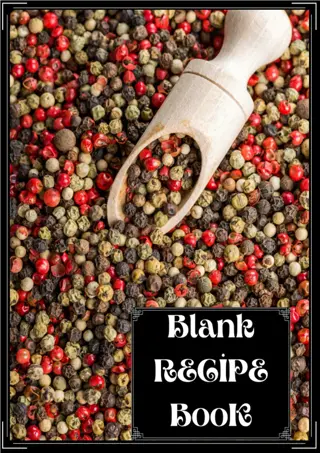
![[✔PDF✔⚡] ✔DOWNLOAD✔ Blank Recipe Book For Holiday Season: My Holiday Recipe](/thumb/68037/pdf-download-blank-recipe-book-for-holiday-season-my-holiday-recipe.jpg)
![GET [✔PDF✔] DOWNLOAD✔ My Vegan Recipe Notebook for all your recipes - 6x9 i](/thumb/68090/get-pdf-download-my-vegan-recipe-notebook-for-all-your-recipes-6x9-i.jpg)
